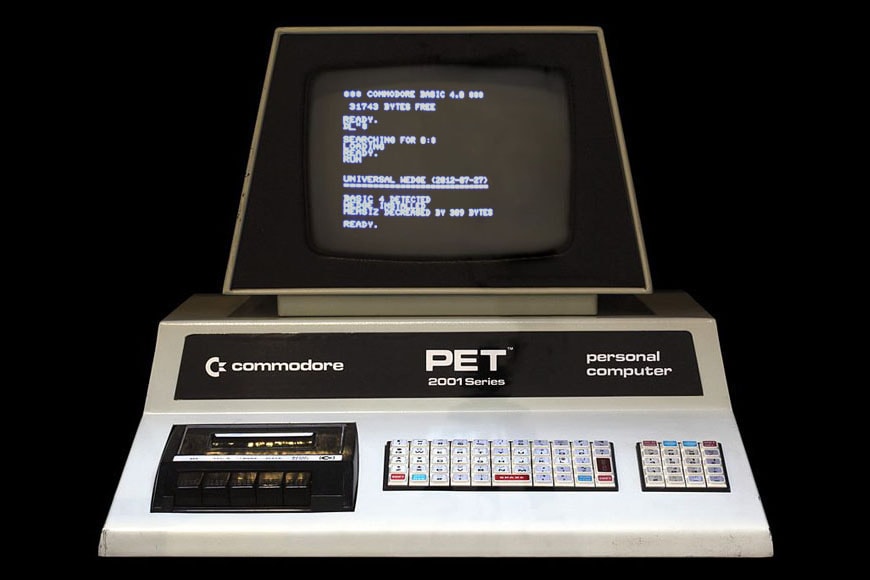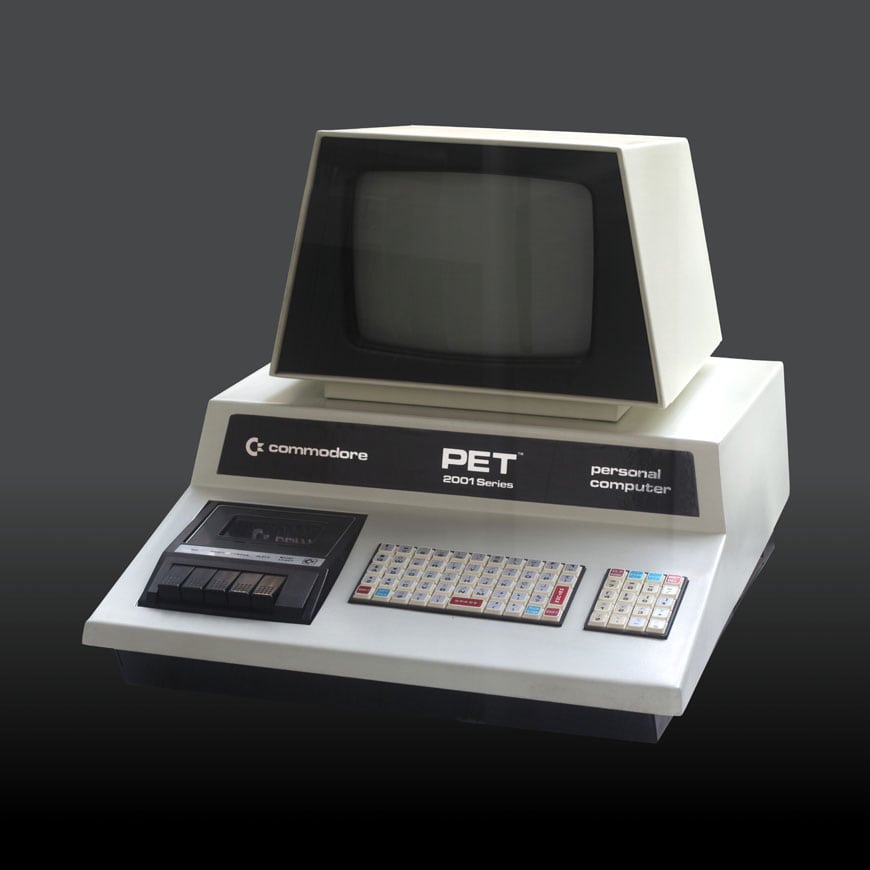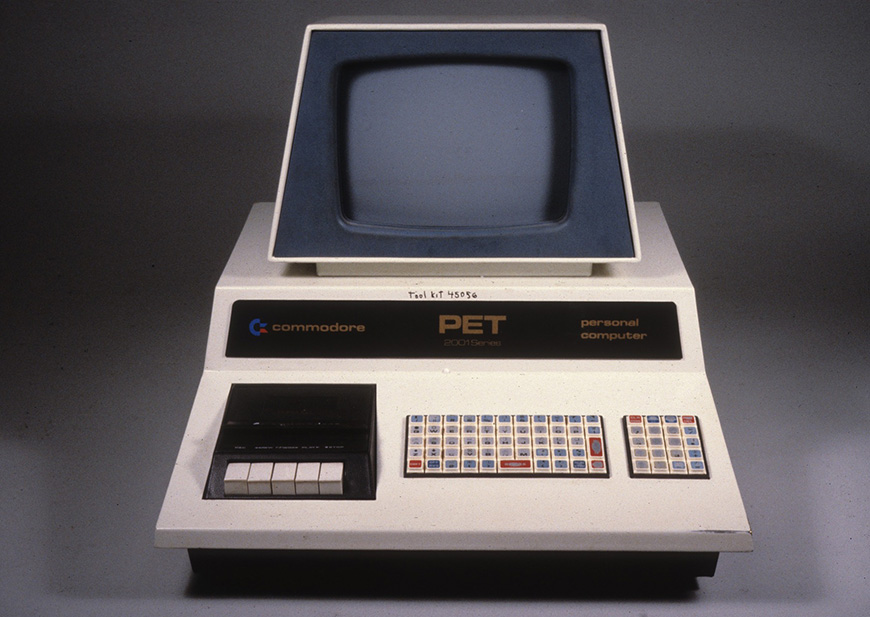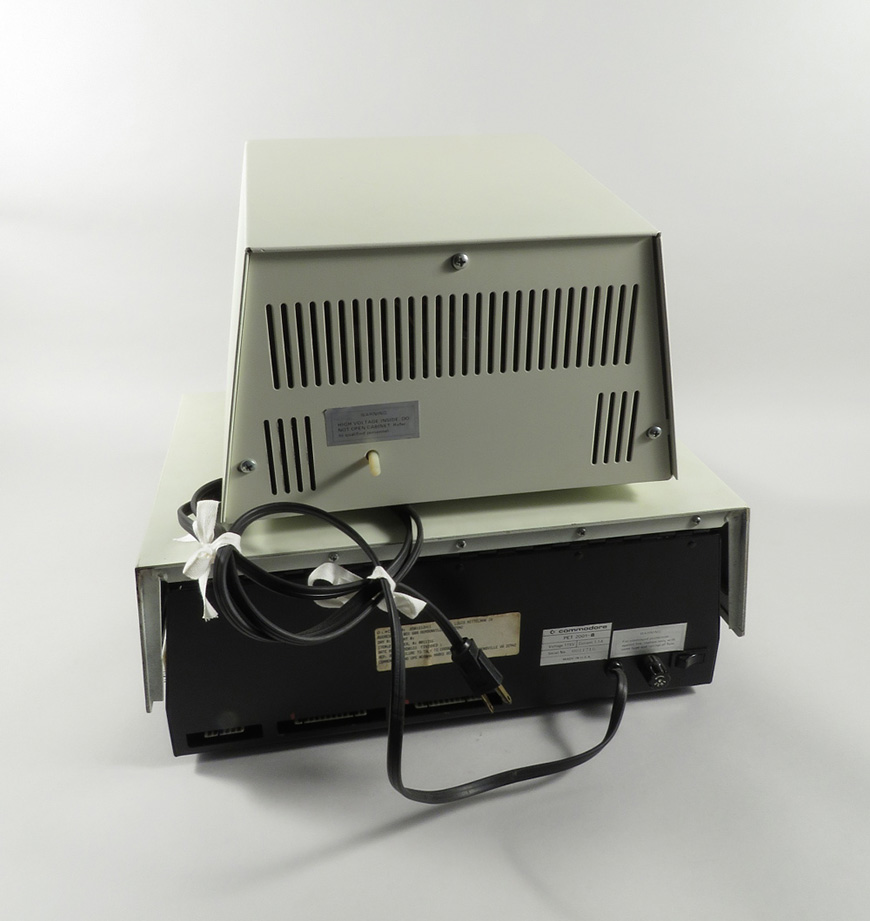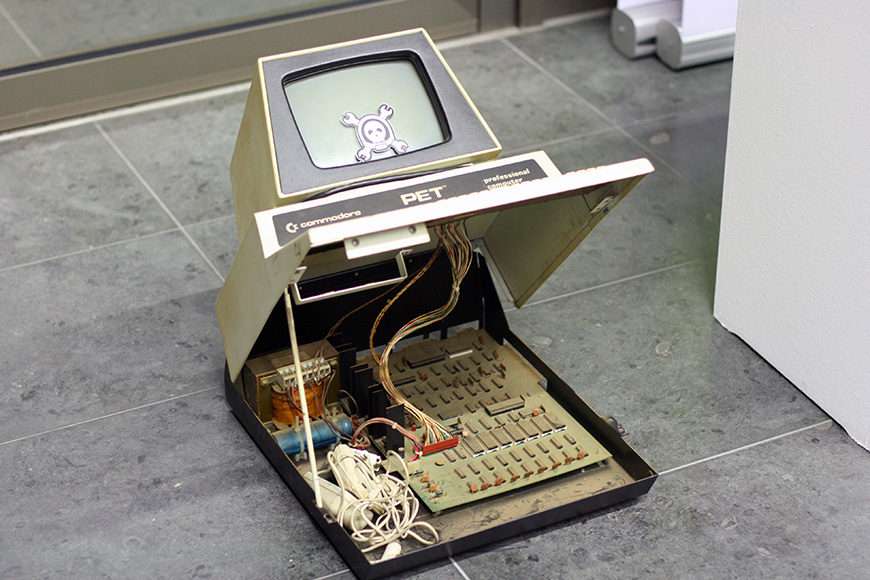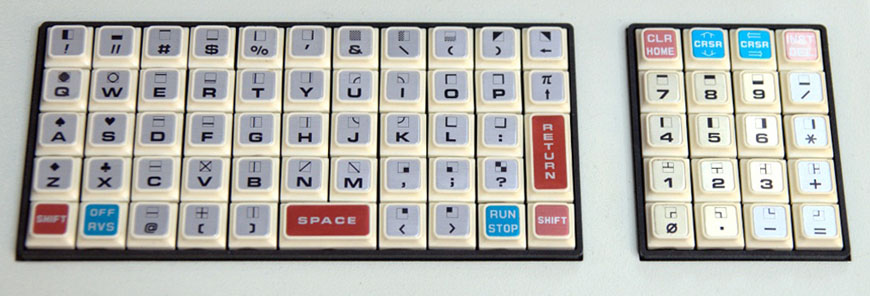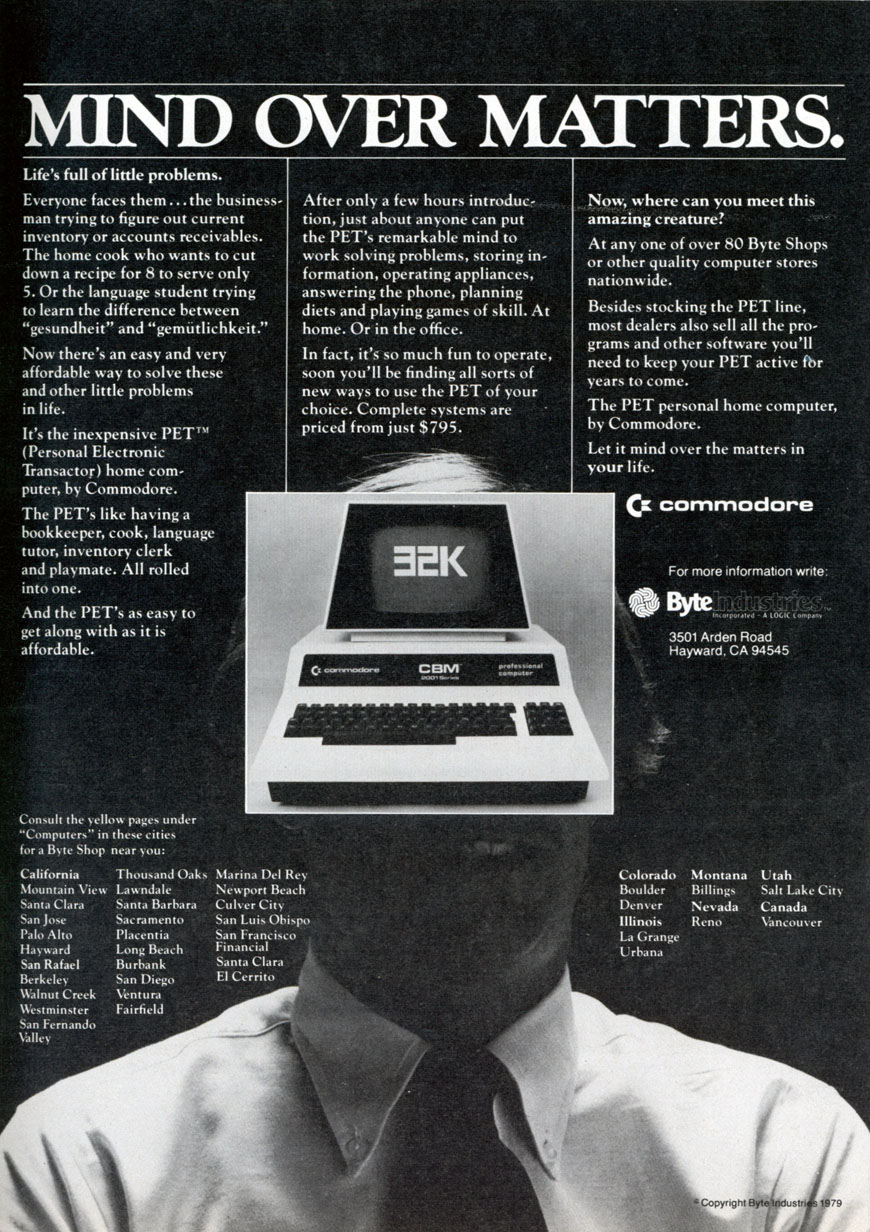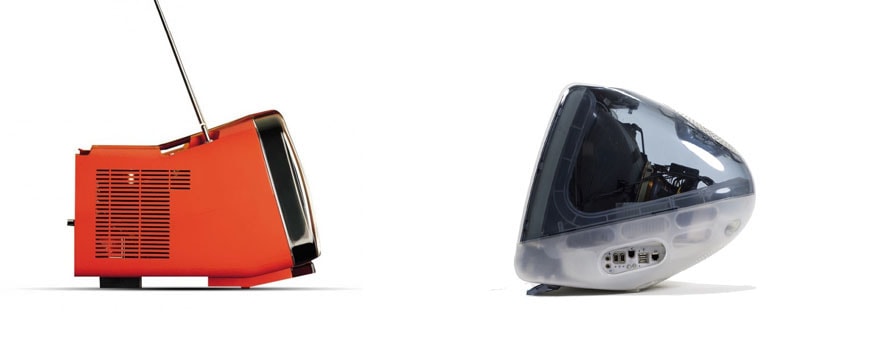The Commodore PET 2001 (1977)
A Commodore PET 2001-8; photo CC BY-SA 2.0 FR by Rama & Musée Bolo via Wikipedia Commons.
History of computer design: the Commodore PET 2001 (1977)
Probably, the two men behind the Commodore PET 2001 computer – Commodore International’s founder, Jack Tramiel, and the company chief designer, Chuck Peddle – would have preferred to call it HAL 9000.
Indeed, many elements of this famous late-70s PC were somewhat inspired by A Space Odyssey‘s infamous thinking machine; from its evocative three-letter name to the PET logo Microgramma typeface (the same used by Kubrick for HAL’s graphic interface), to the addition of the number 2001 which, apart from that reference, is senseless.
Overall, the PET possibly manifests the influence of the cinema aesthetic on computer design like no other machine.
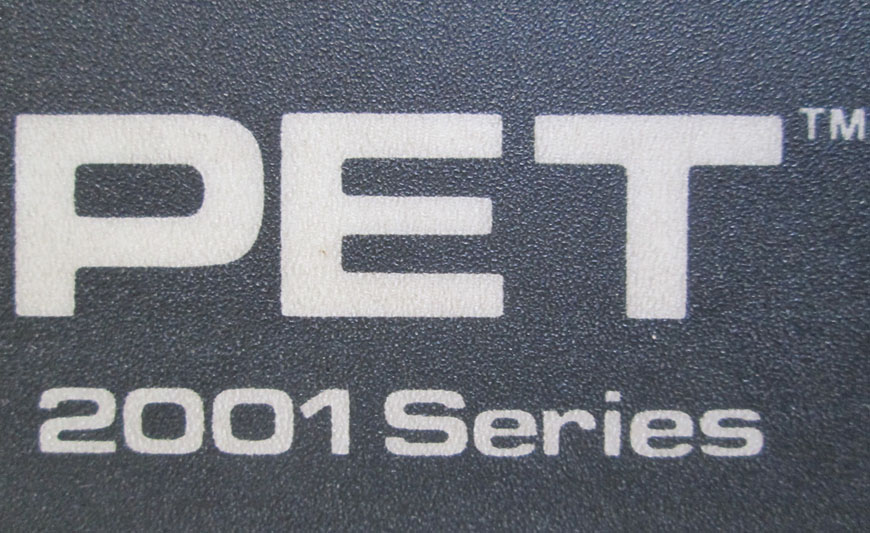
Both the PET logo and the cryptic letters displayed on HAL’s monitors were written with the same typeface, Microgramma. The font – designed in the early ’50s by two Italian type designers, Aldo Novarese and Alessandro Butti – was quite popular in the Seventies and widely used in technical publications (top: the original PET 2001 logo; down: a reproduction of the 2001: A Space Odyssey’s HAL 9000 console from “Stanley Kubrick: The Exhibition” at the Design Museum London, 2019)
The PET 2001 can be considered the first all-in-one home computer and, in many aspects, the first commercially successful personal computer ever.
It was based on a MOS 6502 processor (which also powered the Apple II) and equipped with a cassette recorder as a mass memory device, a keyboard with 53 buttons, a 20-button numeric keypad, and a 9-inch monochrome CRT monitor (manufactured by Sony).
The default RAM amounted to only 4 KB; yet, Commodore quickly released a version with 8 KB to improve the machine’s performance.
All elements were grouped into a single massive sheet metal case; overall, the PET weighed about 25 pounds. As usual for many computers of the time, the machine included, along with a minimal Operating System, a programming language pre-installed in ROM: it was a version of BASIC produced by a small company from Albuquerque, called Micro-Soft, and developed by its young co-founder, William Henry “Bill” Gates.
In a famous image taken in 1981, Microsoft’s founders, Bill Gates (then 26) and Paul Allen (then 28), proudly pose with some computers using their company’s software, including an Apple II, an Intertec Superbrain, a Sanyo MBC-550, a Zenith Data Systems Z-19, a TRS-80 I, and, in a prominent position, a Commodore PET 2001.
For the European market, the Commodore PET (which means Personal Electronic Transactor) was renamed to Commodore CBM (Commodore Business Machine) to avoid a dispute with Philips, which had already trademarked the name PET for a new computer, called Programm-Entwicklungs-Terminal.
The PET’s original name wasn’t an acronym, the Commodore wanted the name to be a three-letter one (both as a reference to Kubrick and to mimic IBM), and “pet” seemed appropriate and friendly; therefore, a (rather) reasonable meaning for that name was creatively invented later.
There is little doubt that its peculiar trapezoid-shaped monitor is the hallmark of the PET 2001 housing – designed by Chuck Peddle with an industrial designer, Larry Hittle.
Despite the all-in-one concept of the PET, nevertheless, the monitor looks more like a separate piece “welded” to the computer’s sturdy base than a fully integrated element (yet, this was common to almost all unibody computers of the time, until the advent of the Macintosh).
Photo CC BY-SA 2.0 FR by Rama & Musée Bolo
Front and rear views of a computer Commodore PET 2001-32; photos Louis Mittelman, Jr., courtesy of The Smithsonian under CC0 license.
It should be mentioned, that Commodore originally intended the PET to have a less sharp case made of plastic, but then reverted to a sheet metal container, produced by a Canadian office furniture company also owned by Tramiel, to reduce the computer manufacturing cost.
This move caused issues for Commodore later on since the slow manufacturing process of the metal case became a bottleneck in the production of the large number of machines that clients required after the unexpected quick success of the PET.
Aesthetically, the PET was a typical son of the ’70s, with the same angular forms as many other industrial products of the period, and its bright white case.
In the ’60s and ’70s, white was widely considered THE color of the future, as we can see in various American and European science fiction films, such as The Tenth Victim by Elio Petri (1964), George Lucas’ THX 1138 (1971) and, of course, 2001: A Space Odyssey.
The computer case itself has more than a superficial resemblance with the futuristic video phone with which Dr. Floyd calls his daughter in Kubrick’s film.
The ambitious plan to fit the monitor, electronic boards, mass-memory devices, and keyboard into a single container, small enough to be easily placed on an office desk, caused some problems.
For example, there wasn’t enough room for a real computer keyboard, and Commodore (which also produced electronic calculators) replaced it with a small calculator-style rubber keyboard. Unfortunately, such a chicklet keyboard was not appropriate for writing long texts since it lacked proper tactile feedback, therefore the user had to constantly check on the display if a letter had been typed (a more effective plastic keyboard was introduced later on).
An interesting feature of the PET case was that it was composed of two parts, hinged to one another, to be quickly and intuitively opened like a car hood (it even included a prop rod).
The open case of a PET 2001 clearly shows its two-piece design, with its opening mechanism inspired by a car hood. Photo by Wolfgang Stief via Flickr CC0 1.0.
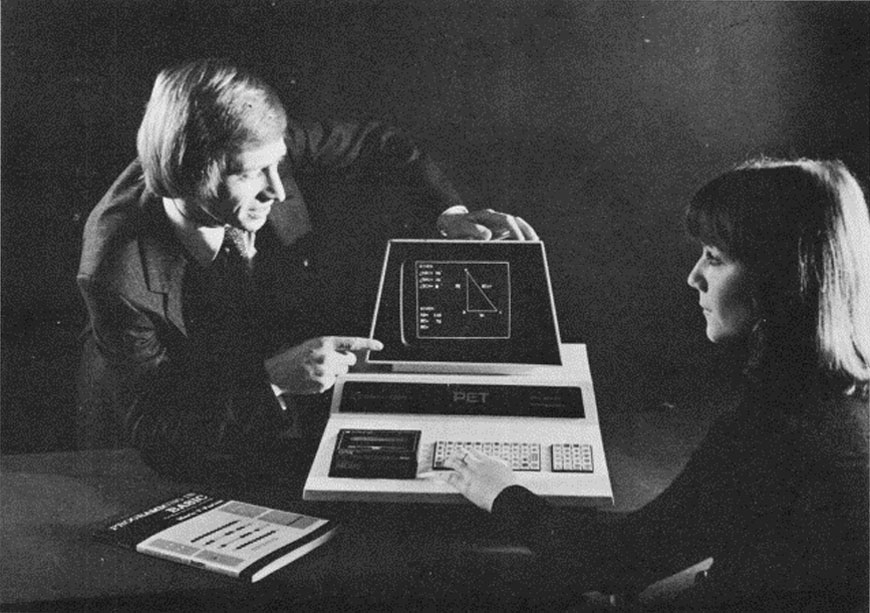
This vintage advertisement of the PET shows how compact the computer is.
The infamous “chicklet keyboard” of the original PET 2001 (up); note how the graphic design of the “shift”, “return”, and “space” keys is similar to that of the HAL 9000’s screenshot from 2001: A Space Odyssey (bottom)
Thanks to its competitive price of less than $600 (2,400 in today’s dollars and about half that of the coeval Apple II and Tandy TRS-80), the Commodore PET was a huge success; believe it or not, in 1980, Commodore was the third-largest personal computer manufacturer in the world.
Unfortunately, both for the PET and Commodore, the golden age didn’t last long; within a few years, two lethal competitors were standing around the corner: the IBM PC and the Apple Macintosh.
Nevertheless, after the PET, Commodore was still able to create a sequence of successful products during the ’80s – comprising inexpensive home computers such as the Vic-20 and the Commodore 64, and the graphics-oriented machines commercialized under the brand name Amiga – which prolonged its life until 1993 when the company was finally forced to declare bankruptcy.
Also due to its being a relatively cheap computer, the Commodore PET was appreciated by schools and educational institutions, as you can see in this photo taken at the American Museum of Science and Energy in Oak Ridge, Tennessee in 1983; photo CC0 1.0 by Frank Hoffman / Department of Energy Oak Ridge via Wikimedia Commons.
An advertisement of the 32KB version of the PET 2001 (in this case, marked as CBM)
copyright Inexhibit 2024 - ISSN: 2283-5474

